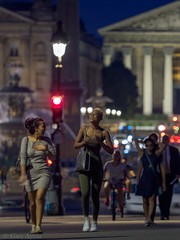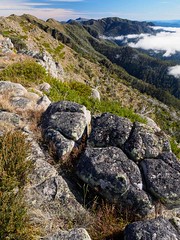Following on from my previous post on getting shallower depth of field for flash filled sunlit portraits by using a trick to use a higher shutter speed with a normal flash, this post is about doing the same but using a high shutter speed sync flash (HSS or Super FP as it is termed).
In the 1970’s, Olympus invented off-the-film TTL flash for their OM2, and in the 1980’s went a big step forward again when Olympus invented Super FP flash for their OM3 and OM4 film cameras that would allow the flash to operate at all shutter speeds not just up to the x-sync speed of 1/60th sec (as it was in those days and 1/160th-1/250th sec in most digital cameras now).
Since then, the other manufacturers have adopted this technology and while Olympus calls it Super FP mode, Canon calls it High Speed Sync (HSS), and for brevity I will just call it HSS here.
The main purpose of HSS is to allow outdoors flash at high shutter speeds so that you can balance with sunlit ambient light and still have a relatively wide aperture for shallow depth of field portraiture.
The good news is that it is quite simple to use and allows shutter speeds up to 1/8000th sec usually, and thus apertures of even f/1.2 depending on the strength of your ND filter.
The bad news is that you need a camera and flash that will allow this, and the maximum output of your flash in this mode decreases very rapidly as your shutter speed becomes faster – typically, the flash output halves for every 2 stops shutter speed up from the x-sync speed.
Unfortunately, Canon do not publish the maximum GN available for each shutter speed for their main flash – the 580EXII – I can’t find it anywhere in their user manual, but the following is from the Olympus FL-50 user manual:
Note that instead of using a ND8 filter for the below calculations, if your camera is capable, you can use ISO 50 and ND4 filter instead. If your camera’s ISO starts at ISO 200 then life is that much more difficult as you are not going to want to use a 4 stop ND 12 filter as you will have trouble focusing, so you will have to settle with a 1 stop higher aperture and more depth of field – sorry Nikon users.
In HSS/Super FP, maximum flash distance remains unchanged (~3.5m when using the FL50 at full zoom and using -1EV fill), and the figures below assume you want to fill flash at 1 stop under the ambient sunlight exposure as an example.
Using x-sync instead of HSS allows you to effectively gain more flash output and thus maximum distance or in reality, ability to use soft boxes with your flash, as you shorten shutter speed BUT at a cost of an increasingly large unlit band at the bottom of the image which limits this to 1/400th sec.
| Olympus FL50 at ISO100 and zoom at 85mm focal length in 35mm terms | Normal X-sync |
Super FP mode |
| GN in m at maximum output at 1/180th sec | 50 | 30 – yep we already have taken a hit! |
| aperture bright sunlight at 1/180th sec | f/12 (f/4.2 with ND8) | f/12 (f/4.2 with ND8) |
| maximum flash distance in meters | 5.6m | 3.4m |
| GN in m at maximum output at 1/250th sec | 50 | 25 |
| aperture bright sunlight at 1/250th sec | f/9.8 (f/3.5 with ND8) | f/9.8 (f/3.5 with ND8) |
| maximum flash distance in meters | 7m | 3.5m |
| GN in m at maximum output at 1/320th sec | 50 but some banding at base of frame | 22 |
| aperture bright sunlight at 1/320th sec | f/8.9+ (f/3.1 with ND8) | f/8.9 (f/3.1 with ND8) |
| maximum flash distance in meters | 7.9m | 3.5m |
| GN in m at maximum output at 1/400th sec | 50 but banding at base of frame 20-30% of image | 20 |
| aperture bright sunlight at 1/400th sec | f/8 (f/2.8 with ND8) | f/8 (f/2.8 with ND8) |
| maximum flash distance in meters | 8.9m | 3.6m |
| GN in m at maximum output at 1/500th sec | 50 but banding covers at least 50% of frame | 18 |
| aperture bright sunlight at 1/500th sec | f/7 (f/2.5 with ND8) | f/7 (f/2.5 with ND8) |
| maximum flash distance in meters | 10m | 3.7m |
| GN in m at maximum output at 1/1000th sec | not possible | 13 |
| aperture bright sunlight at 1/1000th sec | not possible | f/4.9 (f/1.7 with ND8) |
| maximum flash distance in meters | n/a | 3.7m |
| GN in m at maximum output at 1/2000th sec | not possible | 8.9 |
| aperture bright sunlight at 1/2000th sec | not possible | f/3.5 (f/1.2 with ND8) |
| maximum flash distance in meters | n/a | 3.6m |
| GN in m at maximum output at 1/4000th sec | not possible | 6.3 |
| aperture bright sunlight at 1/4000th sec | not possible | f/2.5 (f/1.2 with ND4) |
| maximum flash distance in meters | n/a | 3.7m |
| GN in m at maximum output at 1/8000th sec | not possible | 4.4 |
| aperture bright sunlight at 1/8000th sec | not possible | f/1.7 (f/1.2 with ND2) |
| maximum flash distance in meters | n/a | 3.7m |
Thus, HSS or Super FP mode is great for direct flash fill of sunlit portraits, but if you are doing a wedding group in the sun, your flash GN will be much less for wider focal lengths and you generally will be more than 3.7m away, so you would be better off with using 1 or 2 Metz 45CT, 45CL or 60CT flashes (these have much higher GN at wide angles than a FL50 or 580EXii and you have to use manual mode anyway for this trick) at a slightly higher shutter speed such as 1/250th or 1/320th sec given the unlit portion at the bottom may not come into play anyway.
Likewise, if you are wanting to use your flash in a soft box or bounced, then even at maximum zoom, you may find you don’t have enough flash output in HSS / Super FP mode unless you get in close with the flash, and you may be better off using x-sync.
Lastly, the above figures are just one example. You may wish to slightly over-expose for the sun so that it becomes a kick light such as a hair light which would allow wider apertures and more flash distance, and you may want to change the amount of flash fill – less flash fill needed means more flash distance that can be possible.
Try out your camera and flash combination, and let me know how it fairs by writing a short note in the comments.
Have fun!











Hi Gary,
I use a Canon 40D with a Speedlite 580EXII. I am having problems using the flash for fill flash in full sun portraits. I usually set the camera to Aperture priority and set it as wide as I can to get the shallowest depth of field I can. I have the flash on High speed sync expecting the camera to choose the most appropriate shutter speed working on the theory that the camera and flash unit read each other and therefore the camera “knows” the flash is working and will fire and will select a suitably fast speed. The problem I have is that it doesn’t always seem to do it and I get a horrifically over exposed image. For instance at F4 it selected 1/250th second with the subject in full sun. Unsurprisingly the subject was badly overexposed!! Am I mis understanding the way fill flash works and the camera “talking” to the flash?????
Steve
Hi Steve, I must admit I always use Manual exposure mode when I do TTL flash, then I can set aperture and shutter to what suits ambient, then let the flash do its thing.
I have had very variable experiences using aperture priority with TTL flash.